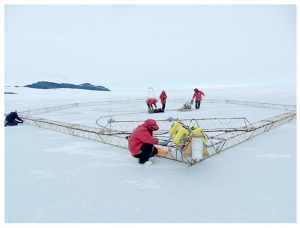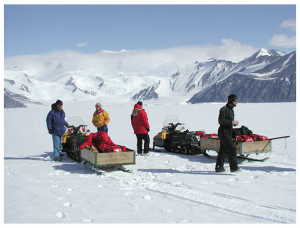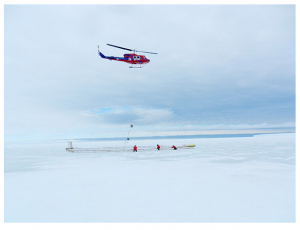Soil Biogeochemistry and Long Term Ecological Research (1989-present)
my research focuses on the polar deserts of Antarctica where I am a co-principal investigator on the NSF McMurdo Dry Valley Long-Term Ecological Research Program. Since 1989, I have studied how climate and soil factors influence the establishment, distribution and function of soil biota. These microscopic soil organisms may serve as sensitive indicators of environmental change and human disturbance.
This research first began in 1989-90 with soil ecologist Diana Wall, Colorado State University, when we first began a three-year project that established that soil nematodes are widely distributed in the McMurdo Dry Valleys. This research also determined that nematode distribution and diversity are related to the soil environment (water availability, chemistry). This initial project began a collaboration that continues today to understand how soil biota respond to climate change and the role of these organism in the biogeochemical cycling of carbon and nutrients essential for life.
This research is now an essential piece of the NSF McMurdo Dry Valley Long Term Ecological Research Program, a site in the NSF LTER Network. Our Antarctica soil ecology research group is the “Victor-Whisky” team also known as the “Wormherders,” a name bestowed by Navy helicopter crews in the early 1990’s. (list compiled by Diana Wall)
In 2002, the LTER group published a paper in Nature (Doran et al. 2002), “Antarctic climate cooling and terrestrial ecosystem response” that reported on dry valley ecosystem change in response to a decadal long period of climate cooling. This paper was widely (mis)used by the climate change “naysayer” community. Peter Doran published an Op-ed in the New York Times in 2006 about this paper, the controversy, and our defense of the science.
Our current NSF LTER is entitled: Increased Connectivity in a Polar Desert Resulting from Climate Warming: The McMurdo Dry Valley LTER Program, 2012-2018
SkyTEM, Exploring the Subsurface (2011- present)
The SkyTEM  project is being conducted by an international research team led by Jill Mikucki, University of Tennessee. This research mapped portions of the McMurdo Dry Valleys and the adjacent Ross Island shoreline in 2011-12 using a time domain electromagnetic (TEM) instrument flown beneath a helicopter to map the distribution of freshwater, ice, permafrost, and saline brines to depths of 250m.
project is being conducted by an international research team led by Jill Mikucki, University of Tennessee. This research mapped portions of the McMurdo Dry Valleys and the adjacent Ross Island shoreline in 2011-12 using a time domain electromagnetic (TEM) instrument flown beneath a helicopter to map the distribution of freshwater, ice, permafrost, and saline brines to depths of 250m.
These data are helping construct the history of the evolution of the dry valley ecosystem and identify subsurface environments that may be suitable for microbial life. In 2015, the SkyTEM team published a paper in Nature (Mikucki et al. 2015), “Deep groundwater and potential subsurface habitats beneath an Antarctic dry valley”, that suggests the existence of widespread brine systems within permafrost and below glaciers and lakes throughout Taylor Valley.
\
Read more about the SkyTEM project in the March 2012 Dartmouth Now article, “Airborne System Allows Researchers to Look Beneath the Antarctic Surface.”


